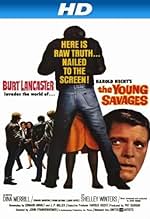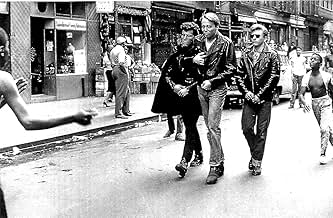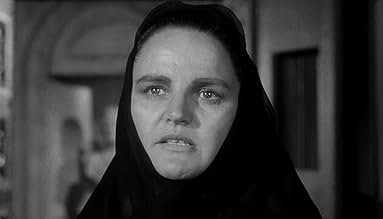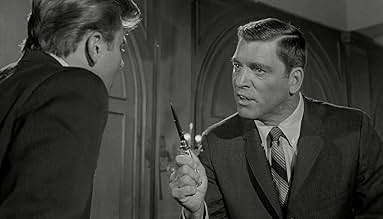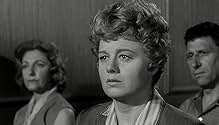AVALIAÇÃO DA IMDb
6,9/10
3,2 mil
SUA AVALIAÇÃO
Adicionar um enredo no seu idiomaA district attorney investigates three white teenagers accused of murdering a blind Puerto Rican kid.A district attorney investigates three white teenagers accused of murdering a blind Puerto Rican kid.A district attorney investigates three white teenagers accused of murdering a blind Puerto Rican kid.
- Direção
- Roteiristas
- Artistas
Neil Burstyn
- Anthony 'Batman' Aposto
- (as Neil Nephew)
José Pérez
- Roberto Escalante
- (as Jose Perez)
- Direção
- Roteiristas
- Elenco e equipe completos
- Produção, bilheteria e muito mais no IMDbPro
Avaliações em destaque
The Young Savages (1961)
Released six months before "West Side Story," this elegant story of New York gang violence in the ghettos of uptown Manhattan is as powerful, and as beautiful. And the title makes clear that the movie is pointing to a new social problem, the immigrant gangs (Italian and Puerto Rican in this case). But in most ways "The Young Savages" couldn't be more different.
At the heart of it all is district attorney Hank Bell, previously Bellini, played by Burt Lancaster in what struck me as possibly the most subtle role in his career. That's an absurd thing to know for sure, and Lancaster is so good so often it's easier to just say he is terrific, but if you know him from some noir films or from "Birdman of Alcatraz" or "Judgement at Nuremberg" you might know a more overtly dramatic actor. Here he is restrained in a perfect way, his pauses and his turned head adding depth to his apparent struggle with how to get at the truth as the events and the witnesses start to swirl out of control. A virtuosic performance.
The themes are hot topic issues layered with good old fashioned love and loyalty. Mostly we have first and second generation immigrant trying to define themselves, to stake out a place in the city, and to fend off competing immigrant groups and sometimes invade their territory. Bell's own Italian-American background makes him understand the problems of youth violence from the inside, but he has avoided being identified as Italian, and even his wife doesn't quite accept him as an immigrant, but wants to see him as more like her, a Vassar girl. Which he is not, even if sometimes he passes as a Yankee or as an old stock New Yorker.
Much of the movie is that wonderful quite and deliberate investigation of the crime, the facts, the witnesses, the evidence. And we see this through Bell's eyes. The last long section is pure courtroom drama, and it's as good as courtroom dramas get, gutsy and tense. In the biggest sense, real justice is achieved, even at the expense of some reputations or expectations around the D.A. (who of course is supposed to always want and get the death penalty). By the final turns of events, you see the story is really about a single man who struggles against his own bias and does the right thing, and does it well. Director John Frankenheimer once again pulls off a movie with social significance that doesn't forget it's roots in theatrical drama.
Cinematographer Lionel Lindon is an old pro, starting with some 1940s boilerplate movies sprinkled with some gems ("The Blue Dahlia" is a great one) and then scores of television shows. And the next year, 1962, he shot "The Manchurian Candidate" which succeeds partly for its amazing visual pizazz. Here, there are both moments of beauty and of cacophony. The fight scenes, and the dazzling murder that starts the movie off, are mini-masterpieces. But even quiet moments are given anxiety and drama by shooting at sharp angles or by moving in close. It's quite a beautiful experience to watch this, even as the events are tumultuous.
Released six months before "West Side Story," this elegant story of New York gang violence in the ghettos of uptown Manhattan is as powerful, and as beautiful. And the title makes clear that the movie is pointing to a new social problem, the immigrant gangs (Italian and Puerto Rican in this case). But in most ways "The Young Savages" couldn't be more different.
At the heart of it all is district attorney Hank Bell, previously Bellini, played by Burt Lancaster in what struck me as possibly the most subtle role in his career. That's an absurd thing to know for sure, and Lancaster is so good so often it's easier to just say he is terrific, but if you know him from some noir films or from "Birdman of Alcatraz" or "Judgement at Nuremberg" you might know a more overtly dramatic actor. Here he is restrained in a perfect way, his pauses and his turned head adding depth to his apparent struggle with how to get at the truth as the events and the witnesses start to swirl out of control. A virtuosic performance.
The themes are hot topic issues layered with good old fashioned love and loyalty. Mostly we have first and second generation immigrant trying to define themselves, to stake out a place in the city, and to fend off competing immigrant groups and sometimes invade their territory. Bell's own Italian-American background makes him understand the problems of youth violence from the inside, but he has avoided being identified as Italian, and even his wife doesn't quite accept him as an immigrant, but wants to see him as more like her, a Vassar girl. Which he is not, even if sometimes he passes as a Yankee or as an old stock New Yorker.
Much of the movie is that wonderful quite and deliberate investigation of the crime, the facts, the witnesses, the evidence. And we see this through Bell's eyes. The last long section is pure courtroom drama, and it's as good as courtroom dramas get, gutsy and tense. In the biggest sense, real justice is achieved, even at the expense of some reputations or expectations around the D.A. (who of course is supposed to always want and get the death penalty). By the final turns of events, you see the story is really about a single man who struggles against his own bias and does the right thing, and does it well. Director John Frankenheimer once again pulls off a movie with social significance that doesn't forget it's roots in theatrical drama.
Cinematographer Lionel Lindon is an old pro, starting with some 1940s boilerplate movies sprinkled with some gems ("The Blue Dahlia" is a great one) and then scores of television shows. And the next year, 1962, he shot "The Manchurian Candidate" which succeeds partly for its amazing visual pizazz. Here, there are both moments of beauty and of cacophony. The fight scenes, and the dazzling murder that starts the movie off, are mini-masterpieces. But even quiet moments are given anxiety and drama by shooting at sharp angles or by moving in close. It's quite a beautiful experience to watch this, even as the events are tumultuous.
Post-World War II, there was a rise in juvenile delinquency, and this was mirrored in films such as "Blackboard Jungle," "Rebel without a Cause," "High School Confidential," and "Knock on Any Door." Antiheroes like James Dean and Marlon Brando became popular, and sexual threats like Elvis Presley invaded music. To adults, the kids were out of control.
"The Young Savages" from 1961 is another film looking at the rise in delinquency, this one starring Burt Lancaster, Shelley Winters, Dina Merrill, and Telly Savalas (in his film debut). Directed by John Frankenheimer, the film is an attempt to get at the psychological reasons behind the murder of a Puerto Rican boy in Harlem.
Lancaster plays DA Hank Bell aka Bellini before his father changed it. He grew up in the neighborhood depicted. Now there is an ethnic division, the Italians versus the Puerto Ricans, with gang activity on both sides - West Side Story sans music.
Hank Bell is to prosecute the juveniles accused of the stabbing, and one of them is the son of a woman (Winters) whom he once dated. She tells him her son could not have been involved in any murder and begs him to look into it. In real life I think he would have had to give the case to someone else, but here, he tries to find out what really happened. Along the way, he learns some things about himself.
Like "Knock on Any Door," "The Young Savages" endeavors to show what's behind the tragedy. Merrill is Karin, Hank's suburban life, with the liberal philosophy of one who doesn't actually deal with juveniles. She's a far cry from Hank's old girlfriend from the neighborhood - Hank has reinvented himself and has a debutante type for a wife. Partly from guilt, partly from "there but for the grace of God," Hank throws himself into the case, endeavoring to see both sides, to the complete annoyance of his superiors.
Good movie with an intense performance by Lancaster. The film is notable also for being Telly Savalas' first film, playing a police detective with shades of Kojak. The juveniles - Stanley Kristien, Neil Nephew, Luis Arroyo, Jose Perez, and Richard Velez, are all excellent.
Though somewhat derivative, this is a good film -- Burt Lancaster's production company was associated with quality films, and this is one of them.
"The Young Savages" from 1961 is another film looking at the rise in delinquency, this one starring Burt Lancaster, Shelley Winters, Dina Merrill, and Telly Savalas (in his film debut). Directed by John Frankenheimer, the film is an attempt to get at the psychological reasons behind the murder of a Puerto Rican boy in Harlem.
Lancaster plays DA Hank Bell aka Bellini before his father changed it. He grew up in the neighborhood depicted. Now there is an ethnic division, the Italians versus the Puerto Ricans, with gang activity on both sides - West Side Story sans music.
Hank Bell is to prosecute the juveniles accused of the stabbing, and one of them is the son of a woman (Winters) whom he once dated. She tells him her son could not have been involved in any murder and begs him to look into it. In real life I think he would have had to give the case to someone else, but here, he tries to find out what really happened. Along the way, he learns some things about himself.
Like "Knock on Any Door," "The Young Savages" endeavors to show what's behind the tragedy. Merrill is Karin, Hank's suburban life, with the liberal philosophy of one who doesn't actually deal with juveniles. She's a far cry from Hank's old girlfriend from the neighborhood - Hank has reinvented himself and has a debutante type for a wife. Partly from guilt, partly from "there but for the grace of God," Hank throws himself into the case, endeavoring to see both sides, to the complete annoyance of his superiors.
Good movie with an intense performance by Lancaster. The film is notable also for being Telly Savalas' first film, playing a police detective with shades of Kojak. The juveniles - Stanley Kristien, Neil Nephew, Luis Arroyo, Jose Perez, and Richard Velez, are all excellent.
Though somewhat derivative, this is a good film -- Burt Lancaster's production company was associated with quality films, and this is one of them.
Overall the film is not an 8 but the cool parts just won't allow me to give it a lower score.When it was first released I was in junior high school and there existed a non-conformist society within a society.These non-conformists wore long dark coats(trench coats ?) and small brimmed dress hats.My older brother used this kind of dress,I thought it looked so cool.The best I could do was a hand-me-down off white coat that had been balled up in the closet.My big head size ruled out using a hat,instead of looking like a teenage gangster I probably resembled a juvenile Colombo.In the film the gang called the Horsemen dress in the coat and hat style,I really could relate to this cool look.Real gang members are used for some parts of the movie.The viewer sees a style of dress that really existed at the time,for me it's history preserved.The slang and look of the young people are what I like about this movie.Among them are Zorro,Pretty Boy,Gargantua and Batman.The outstanding one and for me the scene stealer of the movie is Arthur Reardon one of the accused murders played by John Chandler.Although only involved in violence twice in the movie he goes about it gleefully as it escalates.A complex person he grins telling how he wanted to live on a farm but his parents put him out on the streets to play with bad boys.Most of the time he is sneering giving indication many things in the world annoy him.His character would have no trouble fitting into a current movie. Soundtrack is very good and in one scene sets the viewer up for seeing Diavolo for the first time.The back of his jacket is something else,be ready for it they only show it for a second. The big finale court trial is unbelievable,a fairytale.About the most realistic scene involving Burt Lancaster is when he is at home talking to his wife and reflects on changing his name from Bellini to Bell.Probably especially after one of the Italian gang members yells..What's the matter you ashamed of being a W--?.This is not a Burt Lancaster movie/story,changes were made to fit his image.When asked by a gang member..Do you know why I stomped him? Lancaster gives the correct answer to show his so called tough up bringing.In the book Lancaster's character can't give the answer and is more meek.The character in the movie still has to take a backseat to the young persons maybe all the way to the trunk.Look for the emphasis on poverty,one gang leader lives in a crowded apartment with people laying around. It looks like a combination flop house/sweat shop where sleeping is done in shifts.My favorite touch is a rooster pecking around on the stairwell INSIDE the apartment building(a housebroken slum rooster?)
The sixties were John Frankenheimer's heyday:he directed three classics "birdman from Alcatraz" "the Manchurian candidate " and "seconds" ,all unqualified musts for any cinebuff.
"Young savages " is at first sight ,a more realist "West Side Story" (the Thunderbirds and the Horsemen replacing the Jets and the Sharks),but hindsight shows that ,in the end ,Frankenheimer's work is not more convincing than Wise's -which has other assets anyway- ,as far as social depiction is concerned.The script promised great things.Which counts in favor of Frankenheimer is his impartiality:he never really sides with one of the groups.Some scenes are impressive :the first meeting Lancaster/victim's mother-but the second one gets in the way-,the murder seen thru glasses -which borrows from Hitchcock's "strangers on a train" though,the pack assaulting a young boy at the pool...The magpie syndrome comes back in the scene when Lancaster's wife is assaulted in the elevator :the same thing happened to Glenn Ford's wife in "blackboard Jungle" .
Some ideas or theories are dubious indeed:because Di Pace (what a name!) has a very high IQ -which is not obvious at all,considering his behavior and his conversation-,he might possibly be less guilty than the others.Ah ... and he is also Lancaster's former sweetheart's offspring !The last confrontation Lancaster/Di Pace is supposed to be an almighty fuss:but anybody past infancy has understood the "knife trick" long before the dialog ends.
"Young savages " is not a bad movie ;it's simply politically correct to the core,which the three works I mention above are not.That said ,there are enough surprises,unexpected twist ,and good performances (of course Shelley Winters outshadows Lancaster's bland wife)to sustain interest till the end.
"Young savages " is at first sight ,a more realist "West Side Story" (the Thunderbirds and the Horsemen replacing the Jets and the Sharks),but hindsight shows that ,in the end ,Frankenheimer's work is not more convincing than Wise's -which has other assets anyway- ,as far as social depiction is concerned.The script promised great things.Which counts in favor of Frankenheimer is his impartiality:he never really sides with one of the groups.Some scenes are impressive :the first meeting Lancaster/victim's mother-but the second one gets in the way-,the murder seen thru glasses -which borrows from Hitchcock's "strangers on a train" though,the pack assaulting a young boy at the pool...The magpie syndrome comes back in the scene when Lancaster's wife is assaulted in the elevator :the same thing happened to Glenn Ford's wife in "blackboard Jungle" .
Some ideas or theories are dubious indeed:because Di Pace (what a name!) has a very high IQ -which is not obvious at all,considering his behavior and his conversation-,he might possibly be less guilty than the others.Ah ... and he is also Lancaster's former sweetheart's offspring !The last confrontation Lancaster/Di Pace is supposed to be an almighty fuss:but anybody past infancy has understood the "knife trick" long before the dialog ends.
"Young savages " is not a bad movie ;it's simply politically correct to the core,which the three works I mention above are not.That said ,there are enough surprises,unexpected twist ,and good performances (of course Shelley Winters outshadows Lancaster's bland wife)to sustain interest till the end.
This is an original classic picture , being very worthy in its intention and including faith in American justice . It is set in N.Y. C. where gang leaders lead his groupies on a reign of terror through the streets and slums . These dangerous gangs are called the Horsemen and the Thunderbirds . After three adolescents hoods stab a blind Puerto Rican boy , upright assistant DA Hank Bell (Burt Lancaster) is tasked with prosecuting the criminal case . He's looking for evidences for first degree killing for all three of the teenagers , even 15 year-old Danny DiPace , son of his old sweetheart , Mary DiPace (Shelley Winters who played his former lover , she was actually former lover in real life) . Bell grew up in the neighborhood and investigates the convictions along with Lt. Gunderson (Telly Savalas) . He learns that Escalante may have pulled a knife and was really one of the chiefs of the Puerto Rican gang that fought usually with their Italian opponents . Bell's spouse is upset at the prospect that he's seeking the death penalty for teens and he thinks she's just a liberal living in her own little perfect world . Meanwhile , Hank attempts to find out motivation for killing on the three misfit boys . As he gathers more proofs against his superior , the General prosecutor Daniel Cole (Edward Andrews) . However , he starts to see that it is all far more complicated than it first suggested . Ring leader results to be a young psychopath Arthur Reardon (John Davis Chandler) , a baddie who doesn't seem human . The attorney starts investigating with no results and the bands pull off his owns objectives , leading to an ever higher tension at the justice court .
It is a violent and strong movie by its time about gangs of cruel teens who terrorize the neighborhood , executing a terrible murder and a prosecutor assistant who is determined to do his job and starts to discover that the facts in the case aren't exactly as they seem to be , despite resistance from his superiors . Tough as well as thoughtful entertainment , set in the thunderous sixties . Well-remembered violent drama from the early 60s in which teenager gangs terrorize the entire streets and surroundings executing crimes and violence at random . Interesting script , screen-written by Edward Anhalt , based on the novel "A Matter of Conviction¨ by Evan Hunter . This entertaining as well as thought-provoking film contains thrills , intense drama , upsetting scenes , and with quite convincing , studious atmosphere . In fact , due to the film violent content had great notoriety and important impression as well as some problems with censorship . Very good acting , as always , by Burt Lancaster as a district attorney who pursues justice , investigating the racially charged case of three teenagers accused of a killing . Lancaster had never before worked with a director as Frankenheimer who used such innovative camera angles . He grew to trust John Frankenheimer, and they made four more films together . In fact , Lancaster was forced by United Artists to make four films for low salaries in the 1960s , all of them directed by Frankenheimer : The Young savages (1961 ), The birdman of Alcatraz (1962), The Train (1964) and Seven Days in May (1964) rather than his normal fee , because of cost overruns at his production company , Hecht-Hill-Lancaster, for which he was personally responsible . Acceptable acting by Dina Merrill ; however , Dina said that the treatment she received from director John Frankenheimer on this picture nearly drove her out of the business , as he literally told her at the end of a days' filming that she was the worst actress he'd ever worked with . It displays a very nice as well as memorable support cast , such as Edward Andrews , Shelley Winters , Larry Gates , Telly Savalas , Stanley Adams , Leonardo Cimino , Milton Selzer and unforgettable John Davis Chandler as nasty teen.
Evocative cinematography in Black and White by Lionel Lindon . The picture was well directed by John Frankenheimer and achieved great success . John used strange camera movements , aiming upward and camera on the floor . Lancaster had never before worked with a filmmaker who utilized such innovative camera angles . In fact , Lancaster was startled and dismayed to see these rare work means . At the beginning John worked for TV and turned to the cinema industry with The Young Stranger (1957) . Disappointed his with first feature film experience he came back to his successful television career directing a total of 152 live television shows in the 50s . He took another opportunity to change to the big screen , collaborating with Burt Lancaster in The Young Savages (1961) and Birdman of Alcatraz (62) ending up becoming a successful director well-known by his skills with actors and expressing on movies his views on important social deeds and philosophical events and film-making some classics as ¨The Manchurian candidate¨, ¨Seven days of May¨ and ¨The Train¨ and ; in addition , including some great car races as ¨Grand Prix¨ and ¨Ronin¨ . Rating : Better and average and well worth seeing . The flick will appeal to Burt Lancaster fans . Above average for its thrilling premise as well as hard-hitting entertainment and had the youthful ripping up the seats on its first release .
It is a violent and strong movie by its time about gangs of cruel teens who terrorize the neighborhood , executing a terrible murder and a prosecutor assistant who is determined to do his job and starts to discover that the facts in the case aren't exactly as they seem to be , despite resistance from his superiors . Tough as well as thoughtful entertainment , set in the thunderous sixties . Well-remembered violent drama from the early 60s in which teenager gangs terrorize the entire streets and surroundings executing crimes and violence at random . Interesting script , screen-written by Edward Anhalt , based on the novel "A Matter of Conviction¨ by Evan Hunter . This entertaining as well as thought-provoking film contains thrills , intense drama , upsetting scenes , and with quite convincing , studious atmosphere . In fact , due to the film violent content had great notoriety and important impression as well as some problems with censorship . Very good acting , as always , by Burt Lancaster as a district attorney who pursues justice , investigating the racially charged case of three teenagers accused of a killing . Lancaster had never before worked with a director as Frankenheimer who used such innovative camera angles . He grew to trust John Frankenheimer, and they made four more films together . In fact , Lancaster was forced by United Artists to make four films for low salaries in the 1960s , all of them directed by Frankenheimer : The Young savages (1961 ), The birdman of Alcatraz (1962), The Train (1964) and Seven Days in May (1964) rather than his normal fee , because of cost overruns at his production company , Hecht-Hill-Lancaster, for which he was personally responsible . Acceptable acting by Dina Merrill ; however , Dina said that the treatment she received from director John Frankenheimer on this picture nearly drove her out of the business , as he literally told her at the end of a days' filming that she was the worst actress he'd ever worked with . It displays a very nice as well as memorable support cast , such as Edward Andrews , Shelley Winters , Larry Gates , Telly Savalas , Stanley Adams , Leonardo Cimino , Milton Selzer and unforgettable John Davis Chandler as nasty teen.
Evocative cinematography in Black and White by Lionel Lindon . The picture was well directed by John Frankenheimer and achieved great success . John used strange camera movements , aiming upward and camera on the floor . Lancaster had never before worked with a filmmaker who utilized such innovative camera angles . In fact , Lancaster was startled and dismayed to see these rare work means . At the beginning John worked for TV and turned to the cinema industry with The Young Stranger (1957) . Disappointed his with first feature film experience he came back to his successful television career directing a total of 152 live television shows in the 50s . He took another opportunity to change to the big screen , collaborating with Burt Lancaster in The Young Savages (1961) and Birdman of Alcatraz (62) ending up becoming a successful director well-known by his skills with actors and expressing on movies his views on important social deeds and philosophical events and film-making some classics as ¨The Manchurian candidate¨, ¨Seven days of May¨ and ¨The Train¨ and ; in addition , including some great car races as ¨Grand Prix¨ and ¨Ronin¨ . Rating : Better and average and well worth seeing . The flick will appeal to Burt Lancaster fans . Above average for its thrilling premise as well as hard-hitting entertainment and had the youthful ripping up the seats on its first release .
Você sabia?
- CuriosidadesDuring the commentary she did for the DVD of What Makes Sammy Run?: Part 1 (1959) Dina Merrill said that the treatment she received from director John Frankenheimer on this picture nearly drove her out of the business. He told her at the end of a day's filming that she was the worst actress he'd ever worked with. She said she went home in tears. It got so bad that her co-star Burt Lancaster came to her defense one morning by ridiculing the director's "good mood" as evidenced by the fact that he hadn't insulted Dina yet.
- Erros de gravaçãoAfter Hank Bell is attacked by the gang in the subway car, the next shot opens with the doctor in the emergency room examining a chest x-ray that is obviously reversed.
- Citações
Danny diPace: Don't con me Mr. Bell. Bell! Your name's Bellini, and you're a wop just like me! What's a-matter, Mr Bellini, you're ashamed of being a wop?
Principais escolhas
Faça login para avaliar e ver a lista de recomendações personalizadas
- How long is The Young Savages?Fornecido pela Alexa
Detalhes
- Data de lançamento
- País de origem
- Idiomas
- Também conhecido como
- The Young Savages
- Locações de filme
- Fulton Fishmarket, Fulton Street, Manhattan, Nova Iorque, Nova Iorque, EUA(Bell and Gunderson go to see Angela and her father who works there)
- Empresa de produção
- Consulte mais créditos da empresa na IMDbPro
- Tempo de duração1 hora 43 minutos
- Cor
- Proporção
- 1.85 : 1
Contribua para esta página
Sugerir uma alteração ou adicionar conteúdo ausente

Principal brecha
By what name was Juventude Selvagem (1961) officially released in India in English?
Responda

